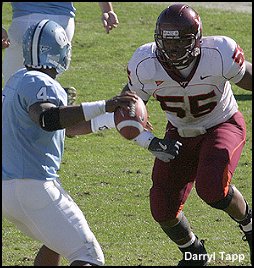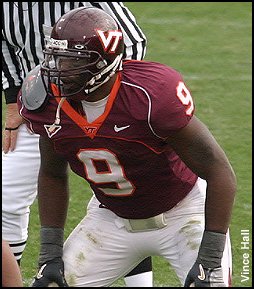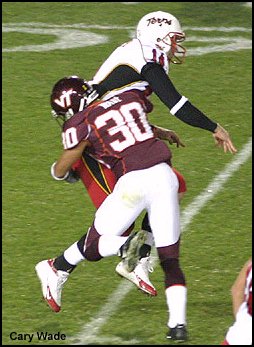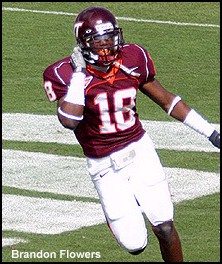While the offense definitely had its moments last
year, especially late in the season, the lynchpin of VTís return to the BCS
was its defense. Gone were the days of laughing quarterbacks, replaced by skill
position players with their heads on a swivel. Paced by an experienced
secondary, and an aggressive, fast front seven, VT had arguably the best defense
in the ACC in 2004.
The Hokies lose some key performers off last yearís
squad, particularly in the secondary. I fully expect for Bud Foster, Whammy Ward
and Jim Cavanaugh to be moving players around trying to come up with the best
possible combination. Nothing will be settled in the secondary until the
incoming freshman report in the fall, so there are legitimate concerns there.
The good news is that the front seven is very,
very good, and they should be able to generate a pass rush without having to
blitz much. The primary goal up front is developing depth for the fall.
Eligibility noted will be as of fall 2005.
Defensive line
Depth Chart:
 End
End
- Darryl Tapp, T-SR
- Jordan Trott, R-SR
Stud
- Noland Burchette, R-JR
- Chris Ellis, R-SO
Nose
- Carlton Powell, R-SO
- Tim Sandidge, R-SR
Tackle
- Jonathan Lewis, T-SR
- Kory Robertson, R-SO
- Barry Booker, R-SO
Defensive Ends Analysis: VT has three
experienced, talented ends returning and will look to see if Trott, a converted
mike linebacker, can provide depth after missing most of last season with a back
injury.
Darryl Tapp will receive a lot of preseason
acclaim, both conference and national, based on his performance last year and
the projected finish of the Hokies this year. He is a strong, relentless player
whose intensity and effort are unparalleled. He makes plays sideline to
sideline, yet also has the physical strength to bull rush an offensive tackle.
Jim Davis was the vocal leader of the players up front last year, but Tappís
work ethic in the weight room and on the field sets the standard for this yearís
team.
Noland Burchette and Chris Ellis are both players
on the rise. Burchette played great football at the close of last year against
Virginia, Miami and Auburn. He has a very good burst off the edge and shows good
closing speed. His run defense also is underrated.
Ellis is one of the more physically gifted
defenders that VT has. He has an NFL defensive end frame, yet he also has
4.6-4.7 speed. The knock against Ellis has been his play against the run, but
that improved as the season progressed last year. Ellis is not close to being a
finished product Ė he needs to play with effort every down and be more
disciplined Ė but his ceiling may be higher than either of the starters.
Jordan Trott hasnít played enough at defensive
end for him to be fairly evaluated. He saw a fair amount of game time two years
ago, but with the transition I would expect that he still has a ways to go in
terms of learning defensive end techniques.
Defensive end is one place where at least one
incoming freshman will play. William Wall, after a prep school year, is expected
to see time and if Trott struggles, Wall's fellow Hargrave recruit, Sam Wheeler,
could also see the field.
Player to watch this spring: Chris Ellis. Ellis
has as much raw ability as anyone VT has had at the position, and a lot of VTís
star defensive ends really go from good to great in their third year in the
program (Corey Moore as a R-JR after he transferred, Cornell Brown as a T-JR,
Tapp as a T-JR). If he can make the step up, then VT may have as good a trio of
ends as anyone in the country.
Key question for the fall: Is Jordan Trott
capable of giving VT adequate depth to allow Wall and perhaps Wheeler to learn
the system? Charley Wiles believes in rotating his linemen, and heíll need to
develop depth. As good as both incoming freshmen may be down the line, itís
tough to expect them to play assignment football in the first month against
teams like N.C. State and Georgia Tech. Trottís development could allow them
to ease into playing time.
Defensive Tackle Analysis: The loss of Jim Davis
is far more significant than his statistics would suggest, but overall this area
is still solid going into the spring.
Jonathan Lewis really stepped up his game last
year and became a major factor inside for the Hokies. He is a strong run stuffer
who frequently commands double teams. Lewis should make some preseason all
conference teams and his presence improves everyone in the front seven.
Carlton Powell played really well last year for a
redshirt freshman. He has very good strength and a nose for the football. He
understands leverage well for a young player. While Davis cannot be replaced,
Powell is a very good prospect who should be a solid ACC level starter this
season.
Tim Sandidge has seen significant playing time
for the last two seasons, and he should be able to add depth. He isnít an
every down performer, but in limited time he is effective. He hopefully will
provide a Kevin Lewis veteran presence to this yearís defensive line.
The player who could burst onto the scene this
spring is Kory Robertson. He has aircraft carrier size (close to 320) while
being surprisingly agile as well. He needs to continue to work on keeping his
pad level low. Improved technique would make him a load to handle on the inside.
Barry Booker is as good an athlete as any
defensive tackle on the roster, but he needs to continue to spend time in the
weight room and maintain down-to-down focus. He shows signs of contributing, but
if he doesnít make a move this fall he risks falling behind the incoming class
on the depth chart.
Player to watch this spring: Kory Robertson. I
have a feeling the light is going to come on for him, and if he does he might be
the best pure run stopper on the roster.
Key question for the fall: Will all three
redshirt sophomores become significant contributors? VT has had some key
recruiting misses on the interior defensive line lately so the Hokies really
need all three to produce for this year and beyond. Ideally, all three incoming
defensive tackle candidates would be able to redshirt this fall.
Linebackers
Mike
- Vince Hall, R-SO
- Brett Warren, T-SO
Backer
- Xavier Adibi, R-SO
- Blake Warren, R-SR
Whip
- James Anderson, R-SR
- Aaron Rouse, R-JR
Analysis: The Hokies have never had this amount
of talent and depth at the linebacker position. Everyone on the two deep has
actual playing experience, and the starters all have star potential. It is
amazing how quickly VT has reshaped this position from a weakness to a strength,
and more help is on the way with incoming recruits Deveon Simmons and Demetrius
Taylor.
 Vince Hall is the prototype middle linebacker as
he is thick through the lower body and explodes when he tackles. As the year
progressed he got better reading his keys and made more impact plays. With his
instincts and physical presence, he probably will end up leading the team in
tackles this fall.
Vince Hall is the prototype middle linebacker as
he is thick through the lower body and explodes when he tackles. As the year
progressed he got better reading his keys and made more impact plays. With his
instincts and physical presence, he probably will end up leading the team in
tackles this fall.
Brett Warren enrolled last January and enjoyed a
very solid initial campaign. Brett has added good weight and strength since he
first matriculated, and he will provide quality snaps. He also will be a big
special teams contributor.
At backer, Xavier Adibi has star potential. His
injury during the USC game really set him back as he lost a significant amount
of weight, which affected his ability to defend the run. Heíll play next fall
around 230 without losing any speed. Adibi plays well in space, is intense, and
could be the best cover backer VT has ever had. There arenít that many
linebackers that can make plays against the run, in coverage and as a pass
rusher, but he has the capability to make impact plays in all facets of the
game.
Blake Warren has starting experience and is a
more than capable backup. Although he doesnít have blazing speed, he has a
good feel for coverage. Having a senior with substantial playing experience as a
backup is a great luxury for Bud Foster.
At whip, the Hokies basically have two starters
that split time in James Anderson and Aaron Rouse. Anderson is an elite strength
and conditioning athlete, and he really flourished with the move to weakside
linebacker last year. He brings better size and strength to the position than
the typical whip and is rarely out of position.
Rouse is an impact hitter. He looks long and
lean, but when he gets a clear shot at an offensive player he can absolutely
unload. He isnít as consistent as Anderson, but his hitting ability gives him
big play potential. Both players are legitimate ACC starters, so this position
is in very good hands.
Player to watch this spring: Xavier Adibi. Hokie
fans really didnít see him at full strength when he did play last fall. With
some time to heal and build his body back up, he should be fun to watch this
spring.
Key question heading into the fall: Does VT have
the best linebacking corps on paper in the ACC? Virginia, Miami and Georgia Tech
all have some talent and experience coming back, but the only ACC team that in
my opinion can challenge the Hokies for overall talent and depth is Florida
Stateís wrecking crew led by Ernie Sims and A.J. Nicholson.
Safeties
Rover
- Cary Wade, R-JR
- D.J. Walton, R-SR
- Corey Gordon, R-SO
- Robert Parker, R-JR
Free Safety
- Justin Hamilton, R-SR
- Kent Hicks, R-FR
- D.J. Parker, T-SO
Analysis: Because the Hokies return so many key
players, most of the position analysis thus far has described how VT needs to
build depth or figure out where a player can best contribute from a position
perspective. In other words, except for the offensive line the Hokies really are
trying to fine tune the car, not get the parts. That is not the case at rover
and safety, where the staff has a bunch of promising athletes but no proven
production.
 Rover is a key position in the VT defense and
right now the picture is entirely muddled. Cary Wade and D.J. Walton both have
some experience, but neither brings the entire physical package to the position.
Both are 5í10Ē and under 200 pounds, and neither has blazing speed. Wade
probably will go into the fall as the starter, but others will certainly get an
opportunity to impress.
Rover is a key position in the VT defense and
right now the picture is entirely muddled. Cary Wade and D.J. Walton both have
some experience, but neither brings the entire physical package to the position.
Both are 5í10Ē and under 200 pounds, and neither has blazing speed. Wade
probably will go into the fall as the starter, but others will certainly get an
opportunity to impress.
Corey Gordon is a terrific physical specimen who
was at free safety last year, but the staff thought he would be best utilized by
moving him closer to the ball. He could very well end up at whip, but I think heíll
get a look at rover because of the need there. He brings great size to the
position, but his ability to cover will be closely scrutinized.
Robert Parker won last yearís strength and
conditioning Iron Man award for VT, and his measurables suggest he could be a
terrific player here. Unfortunately, he has very little experience as he has
played his whole career at wide receiver. I really do hope Parker can emerge,
but I have my doubts about how quickly heíll adapt to the change.
Michael Hinton is a prodigious talent, but Hokie
fans should not expect to see him back on the team this fall. Hinton has spent
his last chance at Virginia Tech.
Donít be surprised if the coaches take a look
at other players at rover, like Roland Minor, Kent Hicks (although he struggled
there on the scout team), D.J. Parker, Brandon Flowers or even Jimmy Williams if
no ones really emerges at rover this spring.
Free safety likewise is wide open. Justin
Hamilton represents everything good about the VT program in that heís been
unselfish, is a great teammate and a talented player. Unfortunately, he hasnít
found his niche yet and is changing positions for at least the third time during
his tenure at VT.
Hamilton has a lot of great attributes: he has
great size, is physical, and he is one of the smartest players on the team.
However, he obviously is not familiar with some key aspects of playing free
safety like having a tight back peddle and learning to take the proper angle
with the ball in the air. It will be a tough adjustment for him.
Kent Hicks is a talented prospect who could be a
real factor this fall. Heís got a great frame, is a long strider that can
cover a lot of ground with the ball in the air, and he isnít afraid to lay a
hit on someone coming over the middle. As a freshman, I would expect Hicks to
occasionally struggle with the demands of making play calls. At the very least,
he won't bring the calming influence that Vincent Fuller did.
D.J. Parker is another possibility at free
safety. Parker has the coverage skills of a corner and the instincts associated
with being a high school quarterback. The coaches want to take a look at him at
free safety and perhaps rover as well. If it doesnít work heíll just go back
to corner.
Of course, there is always the possibility of
Jimmy Williams moving back to free safety. While it would be nice to keep him at
boundary corner given his success there, Jimmyís experience allows him to
swing between any of three positions depending on how things work out with the
other secondary prospects.
Player to watch this spring: All of them. Both
positions are so wide open that it is impossible to focus on one player ďon
the riseĒ or one make or break prospect. The talent is there, but the
experience is not.
Key question going into the fall: Will the
starters be ready for the ACC by September? Even though the starting positions
can be open until the fall, the coaches will need to sort through a bevy of
candidates this spring and slot them at the appropriate position.
With the returning talent up front, hopefully the
free safety will not need to be terribly involved in the running game.
Therefore, I think the player that demonstrates the best understanding of the
passing game, and yields the fewest big plays, will have the inside track.
Incoming freshman Cam Martin may also be able to play early at free safety.
Corners
Boundary Corner
- Jimmy Williams, T-SR
- Brandon Flowers, R-FR
Field Corner
- Roland Minor, R-SO
- D.J. Parker, T-SO
Analysis: The return of Jimmy Williams gives VT
an impact player in the secondary. He is big, physical, fast and tough. At
boundary corner Jimmy takes away a third of the field in coverage and provides
the run support of a linebacker. He got better as the season progressed, and if
he continues to improve he will be a first round draft pick next April. Williams
will be a frontrunner for the Thorpe Award this year.
While the other candidates at corner are young,
the staff seems genuinely pleased by their progress and I feel a level of
comfort with them that I donít really feel with the rover and safety
candidates as of now.
Roland Minor played a significant amount of snaps
this past year as a nickel corner and acquitted himself nicely. He has good size
and is physical. While Minor played primarily on the boundary last year, I
expect him to receive a look at field corner opposite Jimmy Williams this
spring. That will be an adjustment, but he is too talented not to start
somewhere in the defensive backfield.
 As of right now, Brandon Flowers and D.J. Parker
are the backup cornerbacks, but it is possible either or both could be elevated
to the starting lineup with a position change. In fact, it could be argued going
into the spring that the best four defensive backs on the Hokie roster are
Williams, Minor, Flowers and Parker.
As of right now, Brandon Flowers and D.J. Parker
are the backup cornerbacks, but it is possible either or both could be elevated
to the starting lineup with a position change. In fact, it could be argued going
into the spring that the best four defensive backs on the Hokie roster are
Williams, Minor, Flowers and Parker.
Flowers doesnít have ideal size and speed but
he has a nose for the football and tremendous instincts. I have a feeling the
staff will look to get him on the field a lot, whether that means moving Jimmy
Williams to free safety or moving Flowers to rover. He would have played a lot
last year had he not broken his leg.
I have Parker slotted as the backup field corner
for right now, but I expect that position to ultimately be manned by an incoming
freshman, most likely Victor ďMachoĒ Harris or Jahre Cheeseman.
Player to watch this spring: Brandon Flowers.
Hokie fans didnít see a lot of him last fall, but he understands the game. He
has very good footwork and the versatility to perhaps play three different
secondary positions.
Key question going into the fall: How many
players listed above will still be playing cornerback in the fall? The position
is in fantastic shape going forward with the youngsters on board (Flowers,
Minor, Parker, Theodore Miller) and coming in (Harris, Cheeseman, Porch), but
the depth chart is very fluid because of potential personnel moves. Also,
regardless of how talented a secondary is, the ability to function as a unit is
key, and that will be challenging as the coaches integrate this many young
players.